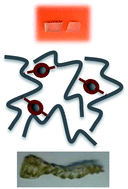In this work, Rozes and co-workers prepared new dynamic materials, that can repair themselves after strong damage, by hybridization of polymers with structurally well-defined nanobuilding units. The controlled design of cross-linked poly(n-butyl acrylate) (PnBA) has been performed by introducing a very low amount of a specific tin oxo-cluster. Sacrificial domains with non-covalent interactions (i.e. ionic bonds) developed at the hybrid interface play a double role. Such interactions are strong enough to cross-link the polymer, which consequently exhibits rubber-like elasticity behavior, and labile enough to enable, after severe mechanical damage, dynamic bond recombination leading to an efficient healing process at room temperature. In agreement with the nature of the reversible links at the hybrid interface, the healing process can speed up considerably with temperature .
Nano-building block based-hybrid organic–inorganic copolymers with self-healing properties by F. Potier, A. Guinault, S. Delalande, C. Sanchez, F. Ribot and L. Rozes, Polym. Chem. 2014, 5, 4474-4479.
Julien Nicolas is a web-writer and advisory board member for Polymer Chemistry. He currently works at Univ. Paris-Sud (FR) as a CNRS researcher.











